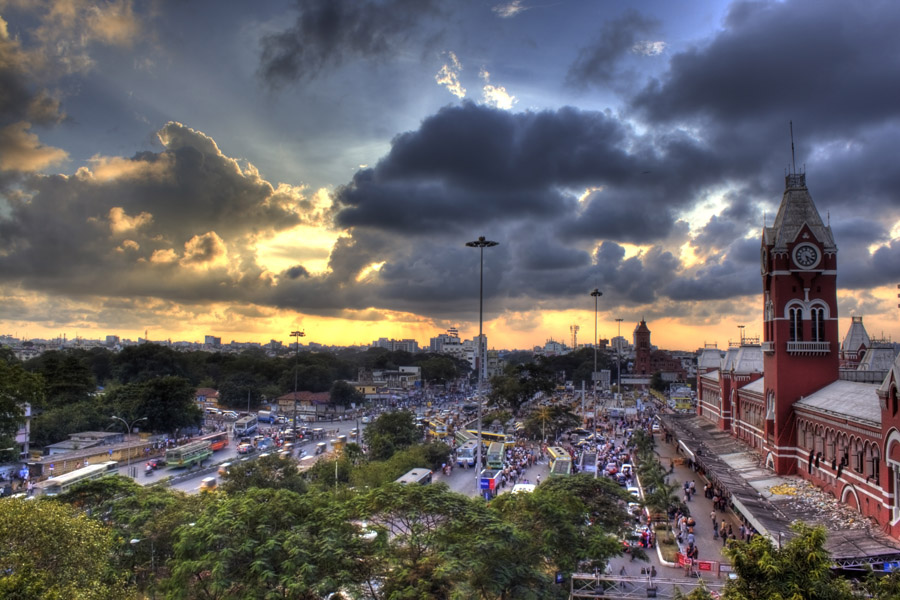Chennai: A Fascinating Mix of Vitality and Traditions


Chennai, the fourth largest city of India, is the capital of the southern state of Tamil Nadu. To understand the history, culture and development of southern India, Chennai is undoubtedly the ideal starting point of your journey. Recently, I was granted a brief but close contact with Chennai with a two-day trip to the city.
Looking around on the descending plane, the verdant land was captured in my eyes. The thriving coconut trees, banana trees, palm trees, banyan vegetation stacked among the buildings, roads, lakes, and newly-constructed skyscrapers, which are rarely seen in the Indian cities.
As I got out of the plane, I was welcomed by Chennai’s unique local customs. The signs here are marked in Tamil and English, and most natives speak in Tamil, or on rare occasions, in English with a very strong accent. Tamil is an ancient language derived from the Dravidian family. Yet commonly used languages of North Central India including Hindi, Urdu, Bengali and Sanskrit are categorized as Indo-European languages. Tamil script dates back to 2,000 years ago, and Tamil literature is also food for thought for the natives.
The paths in the Chennai city are very narrow. With the construction of roads and subways, the city is becoming even more congested, a problem that is commonly seen in a city in transition. Yet most cars run at a relatively high speed. With many two or three-wheeled motorcycles speeding through the cars, foreign passengers have to keep their minds on a stretch. What is interesting, however, is that there is no window on the buses here, only a few rows of iron fences.
Right past noon, we headed for the headquarters of India’s English newspaper The Hindu, traveling by Chennai’s coastal road. Towards the west of the broad streets, antique buildings lie in the green shades, many of which are built in the British colonial period. The boundless Bay of Bengal is towards the east of Chennai. A famous tourist attraction, the Marina Beach is located in this area. Known as the world's second largest beach, Marina Beach is at least a few hundred meters wide, and stretches more than ten kilometers.
It is an ideal place for taking a walk, watch the waves, or to go swimming or surfing. But remember, don’t swim into the deep waters. The Bengal waves are fierce and hit very hard, adding to the unpredictable changes of the undercurrent. At the end of 2004, the Indonesian tsunami hit the beach here, with thousands of people swept away instantly with the huge waves. While appreciating the beauty of nature, don’t forget to always watch in awe.
The Hindu is a hundred-year-old company founded in 1878. It is currently the third largest English newspaper in India, and recognized as the cultural identity of Chennai. Surprisingly, the headquarter of a news organization with such a reputation is only a three-story building, simple and restrained in style.
After finishing work in the office, our next stop is a shopping mall called "EA". Stores filled the street, stuffed with customers and all kinds of goods. Cinemas, restaurants and playgrounds can also be found in the mall. Here in Chennai, there are many more modern shopping malls just like EA, most built in recent years, showing the prosperity of the city and the rapid growth of the local consumption capacity.
On the way back to the hotel, we discovered a white Gothic architecture. The driver explained that this is the famous Gold Saint Thomas cathedral. The car came to a stop, and we took off our shoes before entering the church. In the spacious, magnificent building, a Tamil priest was preaching to hundreds of believers, who are listening peacefully on benches, completely isolated from the noisiness of the outside.
In the courtyard, there is a memorial of St. Thomas. According to legend, St. Thomas, one of the twelve disciples of Jesus, is buried here. He arrived in India in the year 52 A.D., preaching as he traveled, and later passed away in India.
Residents in Chennai are mainly Hindus, but compared with other Indian cities, there is a relatively large proportion of Catholics and Christians. This is because Chennai is one of the strongholds of the British colonists when they first landed in the subcontinent, colonizing the land for a long period; on the other hand, history of this area was not influenced by Islamic culture. The caste system is very strict, people of the lower castes and the Untouchables embraced Catholicism and Christianity as they sought equal rights.
As the sun rose on the second day, we went to the Mahellondra World City Industrial Park of Chennai, bypassing the Group of Monuments at Mahabalipuram. This seashore temple was built in the seventh or eighth century, an outstanding representative of the local ancient architecture and stone carving art that has been included in the world heritage list. The temple is divided into three parts, namely, the Descent of the Ganges, the Shore temple and the Five Rathas. When believers worship the gods, they often touch the hand of Krishna for good luck.
The Mahellondra World City Industrial Park is clean and tidy, with wide roads and carefully distributed plant houses. The air here is very fresh, as it adjoins the sea. Many international companies have set base in the park, including Guangdong’s Greatoo Intelligent Company (India). Greatoo Intelligent (India) began its construction in the park in 2011. On the second years after it has been officially put into operation, it is starting to make profit. The company employed more than 400 Indian workers, and is now looking for a new site in India to expand production capacity. Many similar industrial parks like this one lies in Chennai, reflecting the modernization of the city with their rapid development.
The author is Minister at Chinese Embassy in India.
